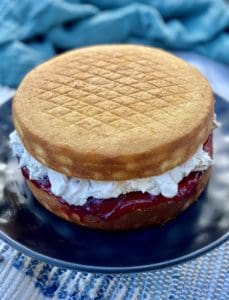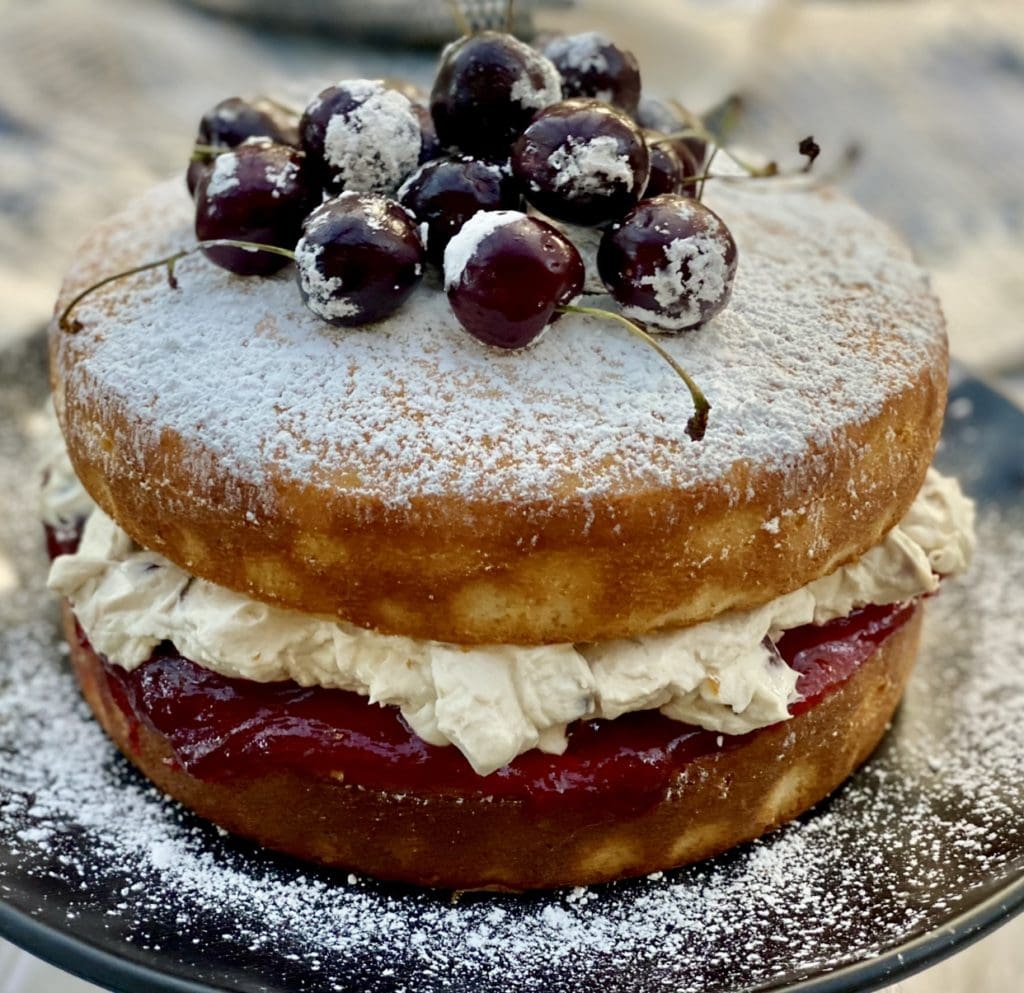
We made this Victoria Sponge cake the Japanese way. It’s plush and light with a lashing of whipped cream, jam and fresh summer cherries
The end of a rainy summer
Summer has left us with 2 weeks of nonstop rain. We are talking about rain continuously pelting down with a rare burst of sunshine in between. Many areas of NSW and Queensland have flooded with many homes destroyed.
After COVID has ruined most of 2020 and 2021, we were hoping 2022 would be a much better year. Unfortunately, 2022 is off to a devastating start. This is a recipe/lifestyle blog and the last thing you probably want to hear is about is war, but the horrible situation in Ukraine has consumed my thoughts.
I feel sick to the stomach seeing and reading the news. When I hug and kiss my toddler, I think of the distraught families in Ukraine feeling scared and helpless. Praying for world peace has never felt more real to me until now.
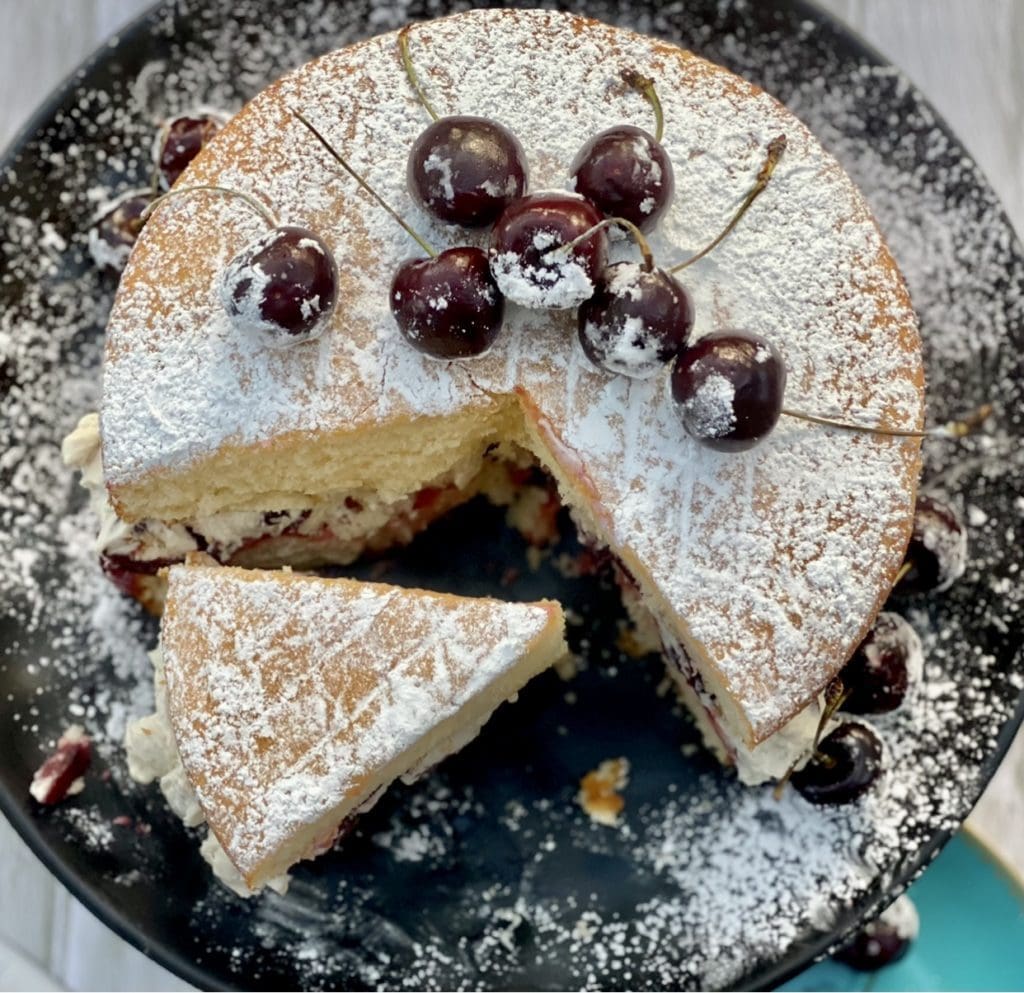
We missed out on a few weeks of summer because My Toddler, Kai, had COVID and our entire household got infected. This meant we missed out on the best summer fruits that were on offer! Like the blink of an eye, the mangoes, peaches or nectarines are almost gone. I was so happy to purchase my first and last bag of fresh cherries before our summer ended.
Besides enjoying cherries on their own, I wanted to create a recipe with them. When a craving struck for cake, I knew I had to make Victoria Sponge Cake with loads of fresh cream and cherries!
A beloved classic cake
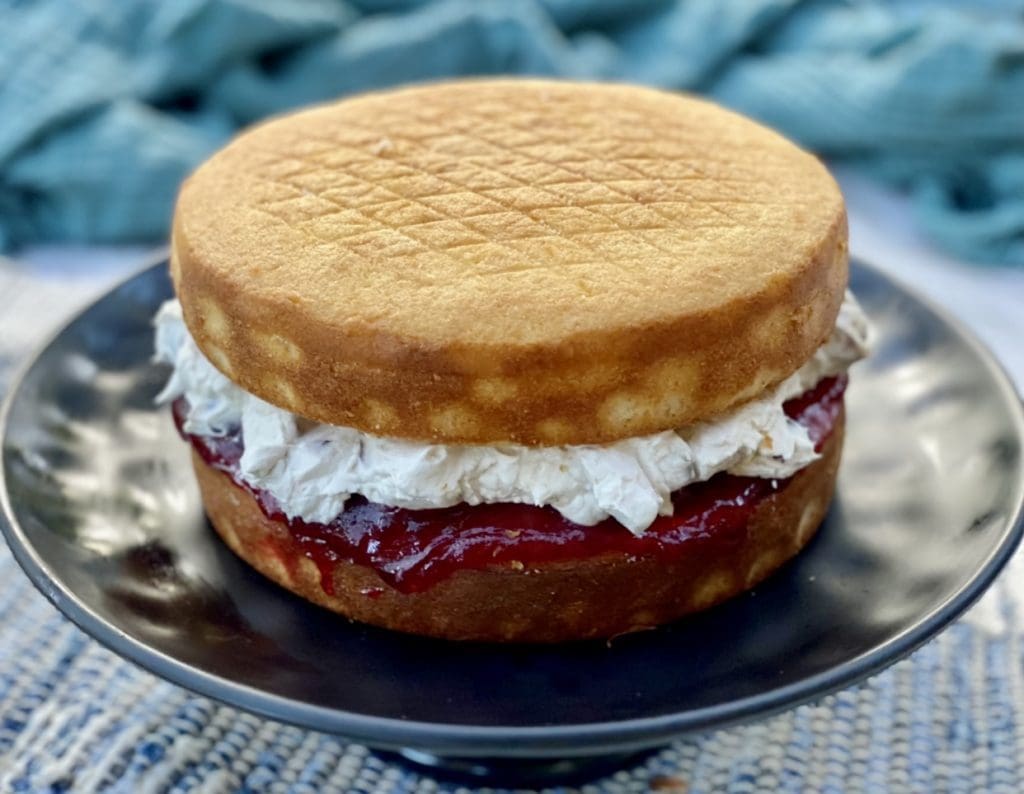
Victoria Sponge Cake has a special place in my heart. It’s a basic cake, but oh boy, it’s satisfyingly good and simply hard to resist.
Back in 2012, I was in London with a friend and we walked by this beautiful bakery. It had a modern but royal charm about it, so we turned back and walked in. They spoiled us for choice because there was an array of stunning cakes to choose from.
My head was urging me to try a cake I never had before, but then I spotted their classic Victoria Sponge Cake. My head lost that battle. I couldn’t get past the generous amount of strawberry jam and fresh cream sandwiched between golden sponge cake.
It’s quite shameful, but I’m not pretentious about it either. I often buy Victoria Sponge Cakes in supermarkets, yup, the ones that cost around $5 bucks for the entire cake! Most of the time I regret it afterwards and get annoyed at myself for not whipping one up instead because it’s so much better.
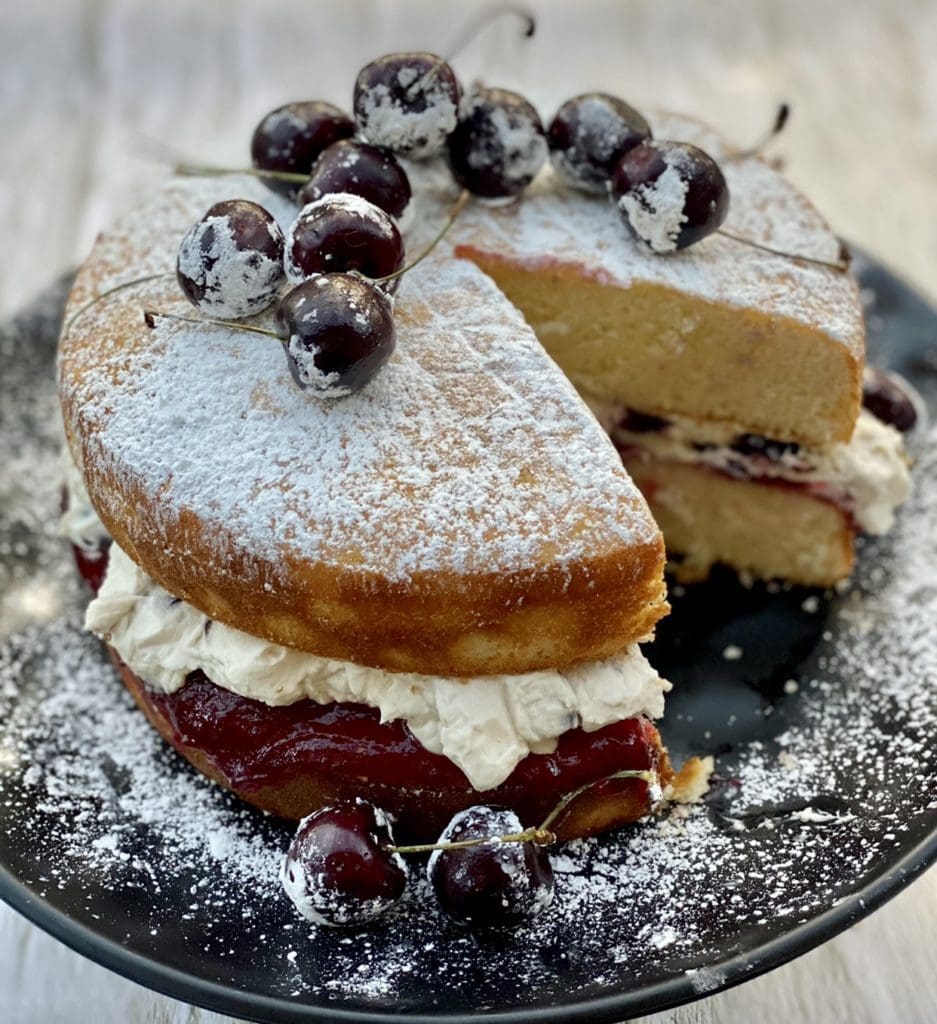
I make this vanilla sponge using the Japanese method for a plush and light cake. There are a few steps involved, but it’s quite straightforward. My tip is to read through the recipe first, understand the steps before starting. It’s definitely worth the effort because it’s less dense than traditional Victoria sponge cake and the cake stays soft for a few days after.
This Victoria sponge cake has a subtle twist, we added a bit of summer into it. Cherry jam and loads of fresh cherries folded into the whipped cream. Truly simple and divine!
For more beautiful cake ideas try our iconic Aussie Lamington cake, or this delicious moist Banana Upside Down Cake with a sticky caramel base.

For the latest recipes, join our FREE 3CatsFoodie mailing list
Ingredients for Victoria Sponge Cake with Fresh Cherries
FOR THE SPONGE CAKE

Plain flour (all-purpose flour) does not have any leavening or raising agents (baking powder) mixed into the flour.
Caster sugar (superfine sugar) – Caster sugar has finer granules than regular white sugar. However, it’s not the same as icing/powdered sugar. Many baking or candy recipes call for caster sugar as it dissolves faster into mixtures. If you can’t find caster sugar, you can use regular white sugar or make your own. Place regular sugar in a food processor or blender, then pulse the sugar a few times until it looks finer, but take care not to over-blitz it to a powder consistency.
FOR THE FRESH CREAM AND CHERRY FILLING

Icing sugar – (powdered sugar, confectionary sugar) – Icing sugar usually comes in two forms, icing sugar mixture and pure icing sugar. Icing sugar mixture is softer than pure icing sugar because there’s starch or flour added to it. For this recipe, I prefer using icing sugar mixture because the starch helps stabilise the whipped cream.
Thickened cream (whipping cream) has gelatine added to it and contains 35% milk fat. I don’t recommend using low-fat cream because it may not whip up well and be a little runny.
Jam – I couldn’t find cherry jam so I used cheap raspberry filling because I prefer them on my cakes and donuts. These are the jams you’ll find in regular bakeries with no seeds and not as firm as proper jam. Regular strawberry, raspberry jam or your favourite type of jam would work.
Cherries – I washed, chopped and pitted fresh for my filling. However, drained canned cherries would also work as a substitute, so would other fresh berries, such as strawberries and raspberries.
How to make Victoria Sponge Cake with Fresh Cherries
Step-by-step guide with photos
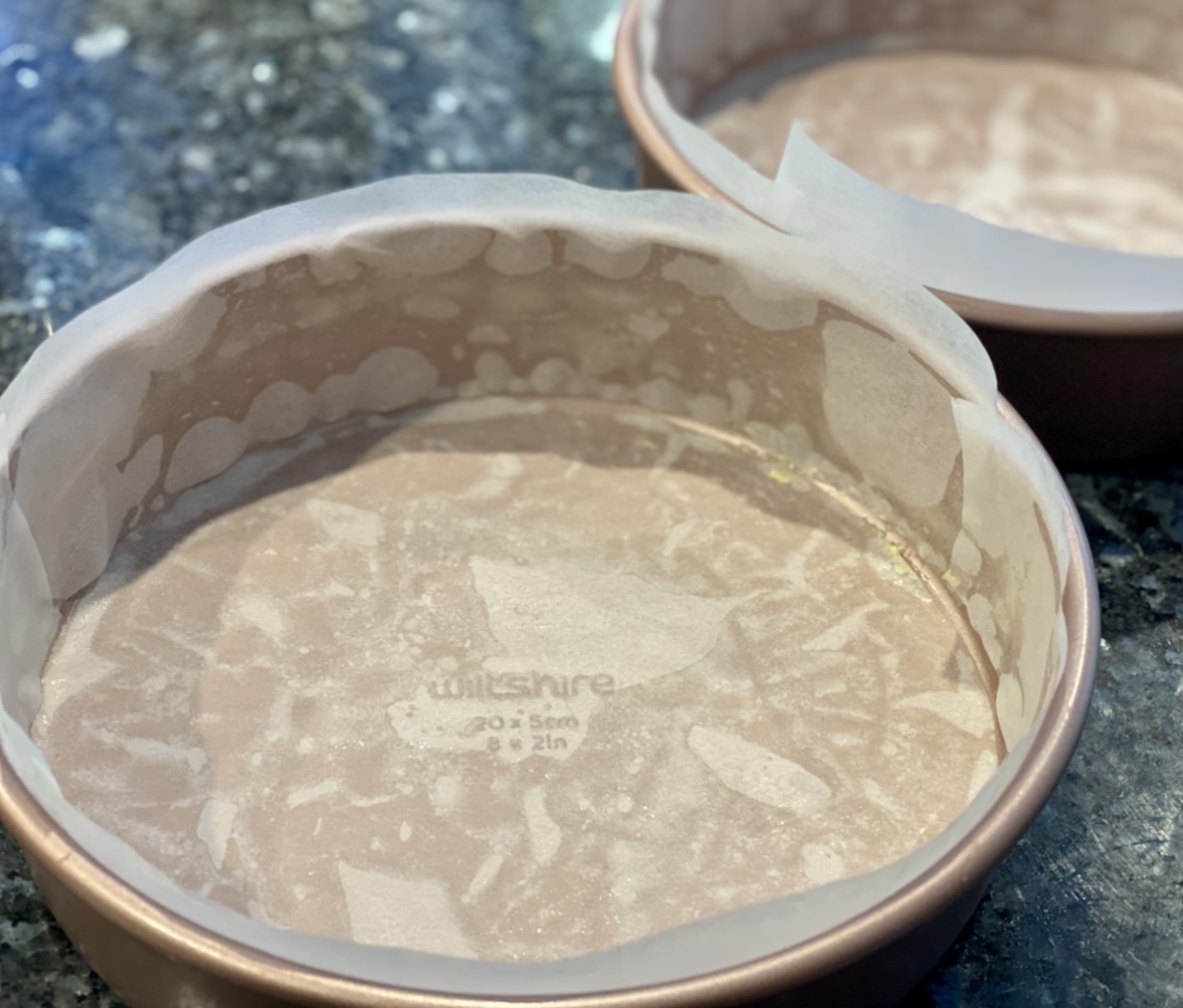

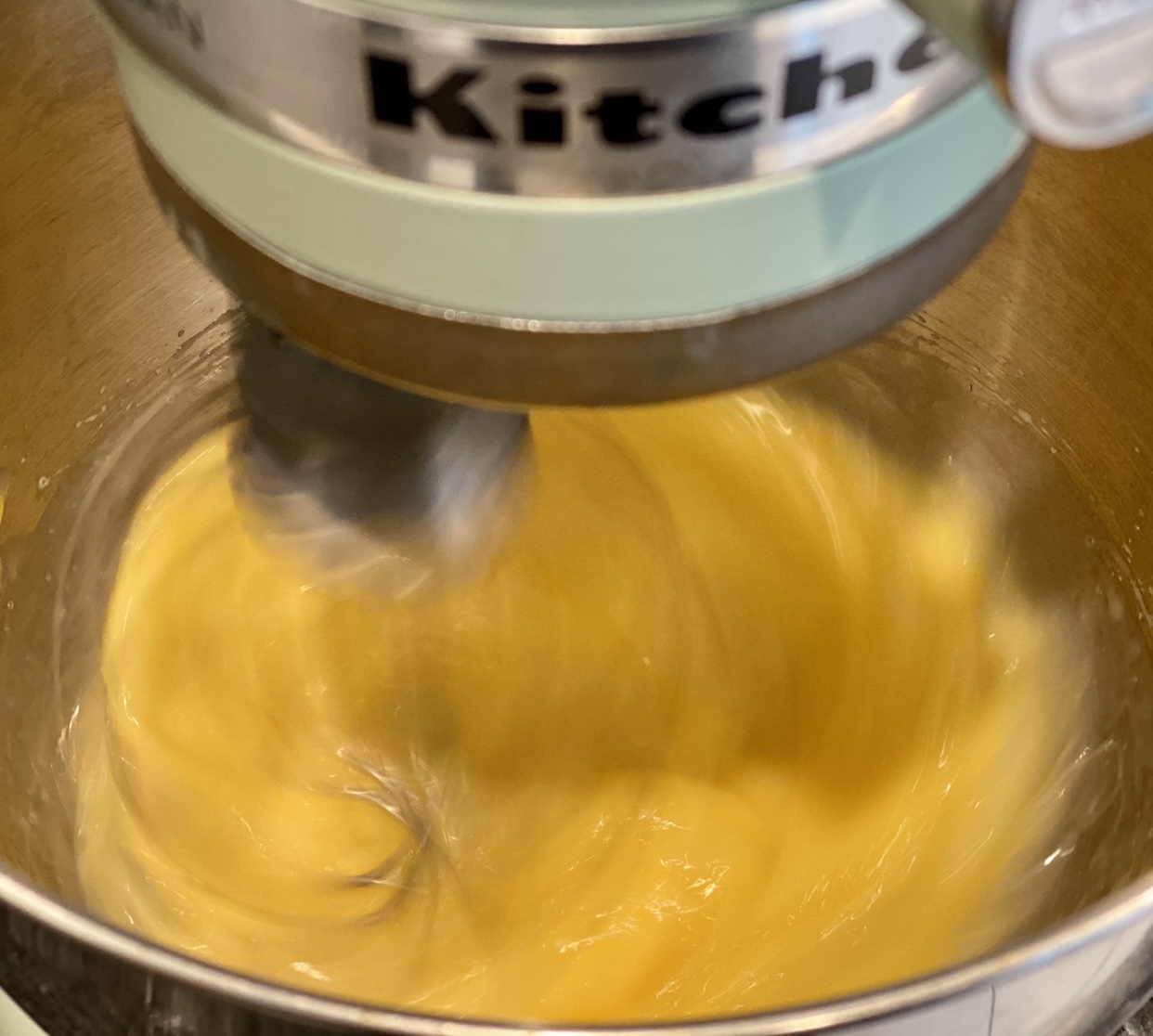
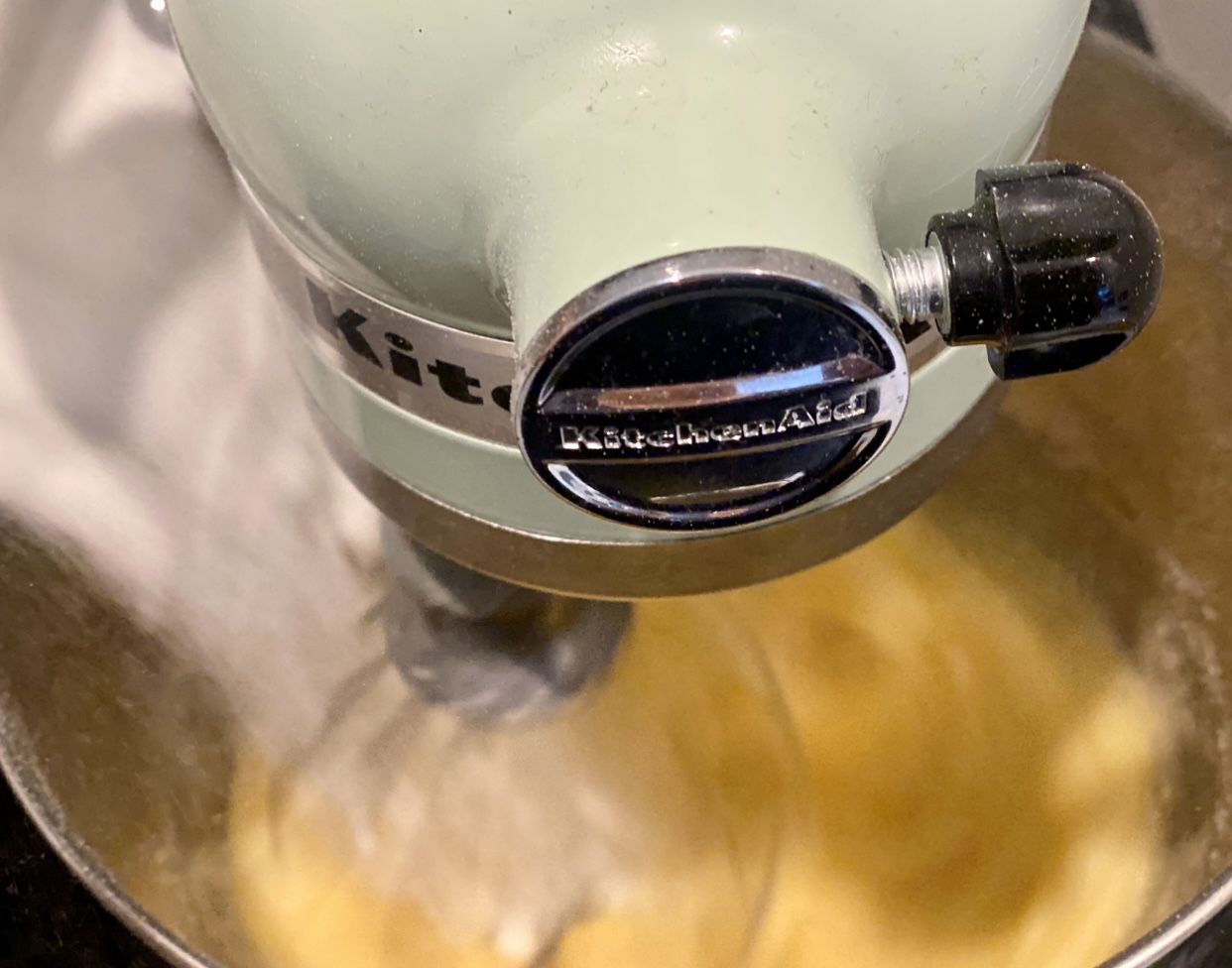
Preheat oven to 180°C (360°F) or 160°C (320°F) for fan-forced ovens. Grease and line 2 x 20cm (8in) pan with non-stick baking paper (parchment paper).
Whisk the eggs in a stand mixer or handheld mixer with the whisk attachment for 30 seconds on medium speed. With the mixer still running, slowly add in the sugar, then increase speed to medium-high and continue to whisk for 6 to 7 minutes or until light and pale.

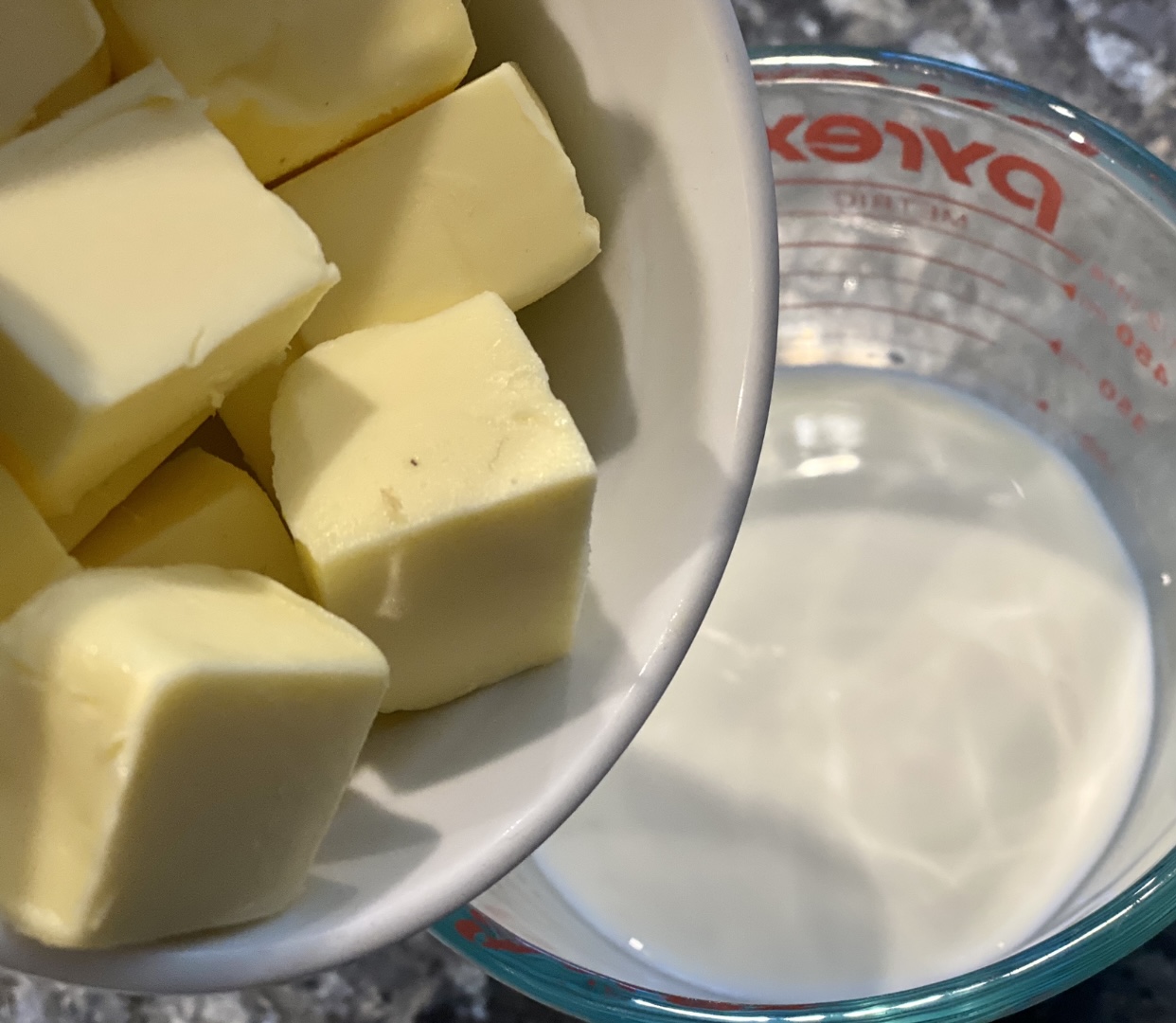

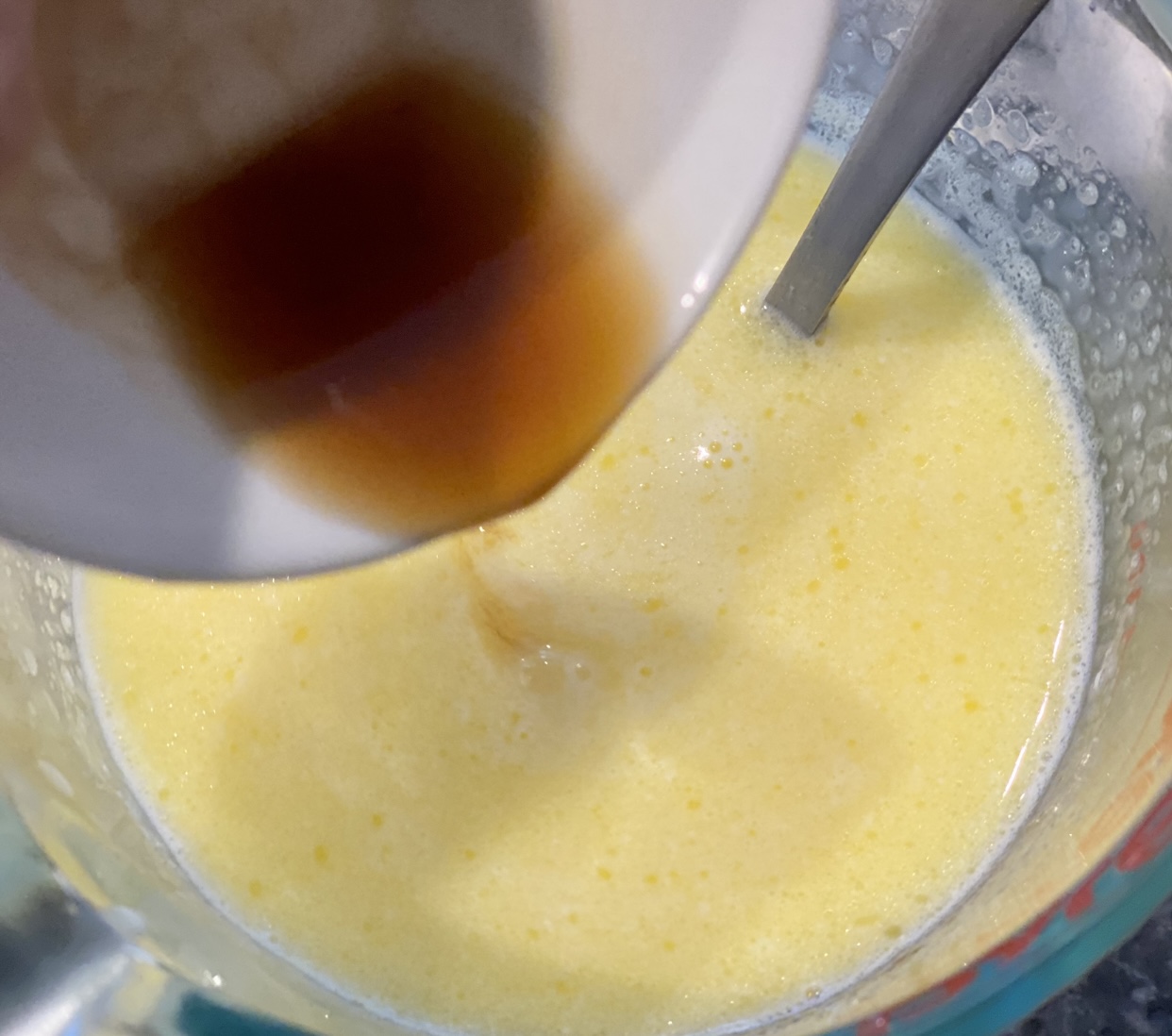
Whilst the eggs are whipping, combine the dry ingredients, flour, baking powder and salt in a large bowl. Hand whisk a few times to combine the ingredients together and set aside for later.
Prepare the milk mixture – In a large microwave-safe jug/bowl, place in butter and milk and microwave for a couple of minutes just until butter melts. Take care not to boil the milk, then mix in the oil and vanilla. Set aside for later.
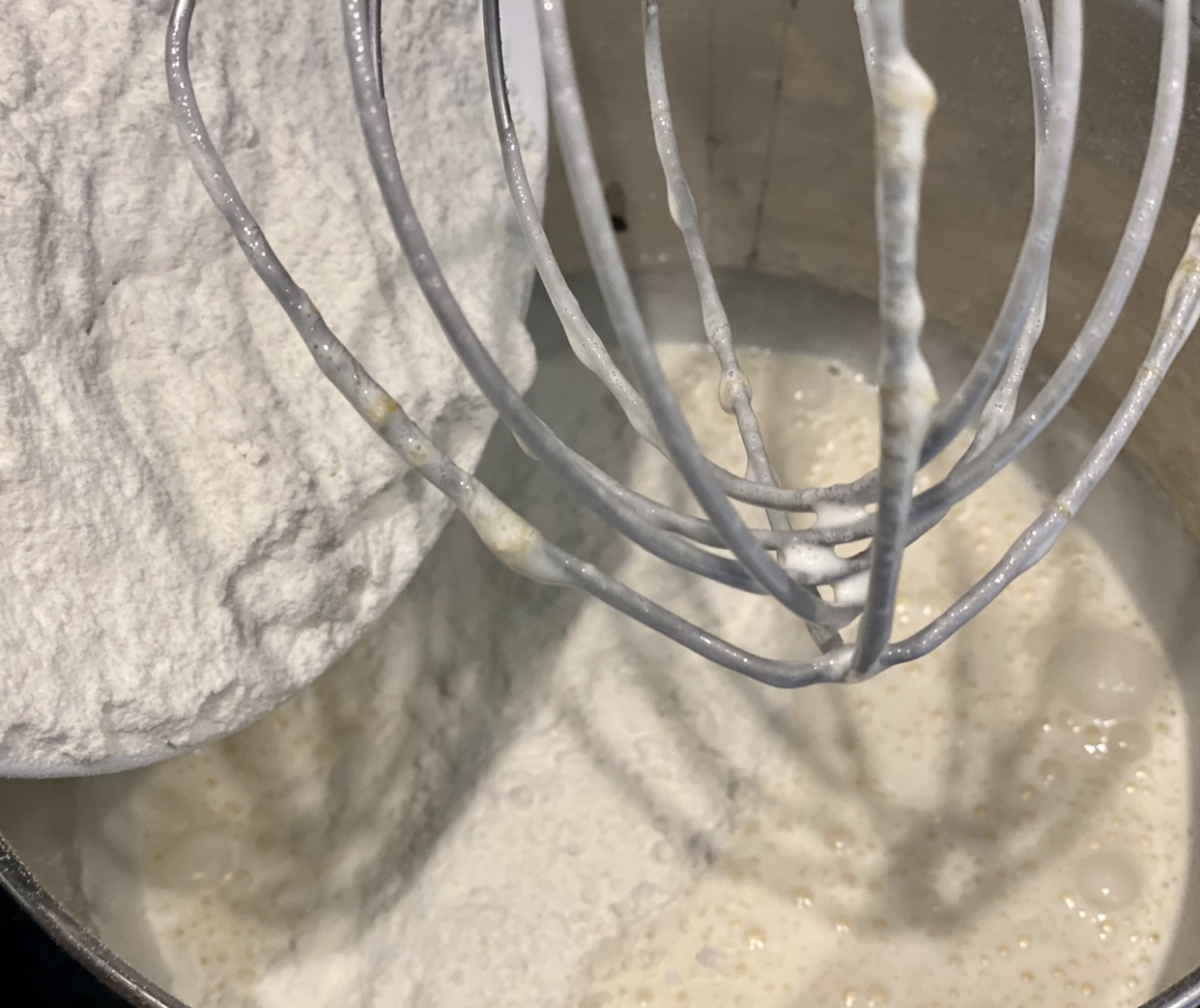
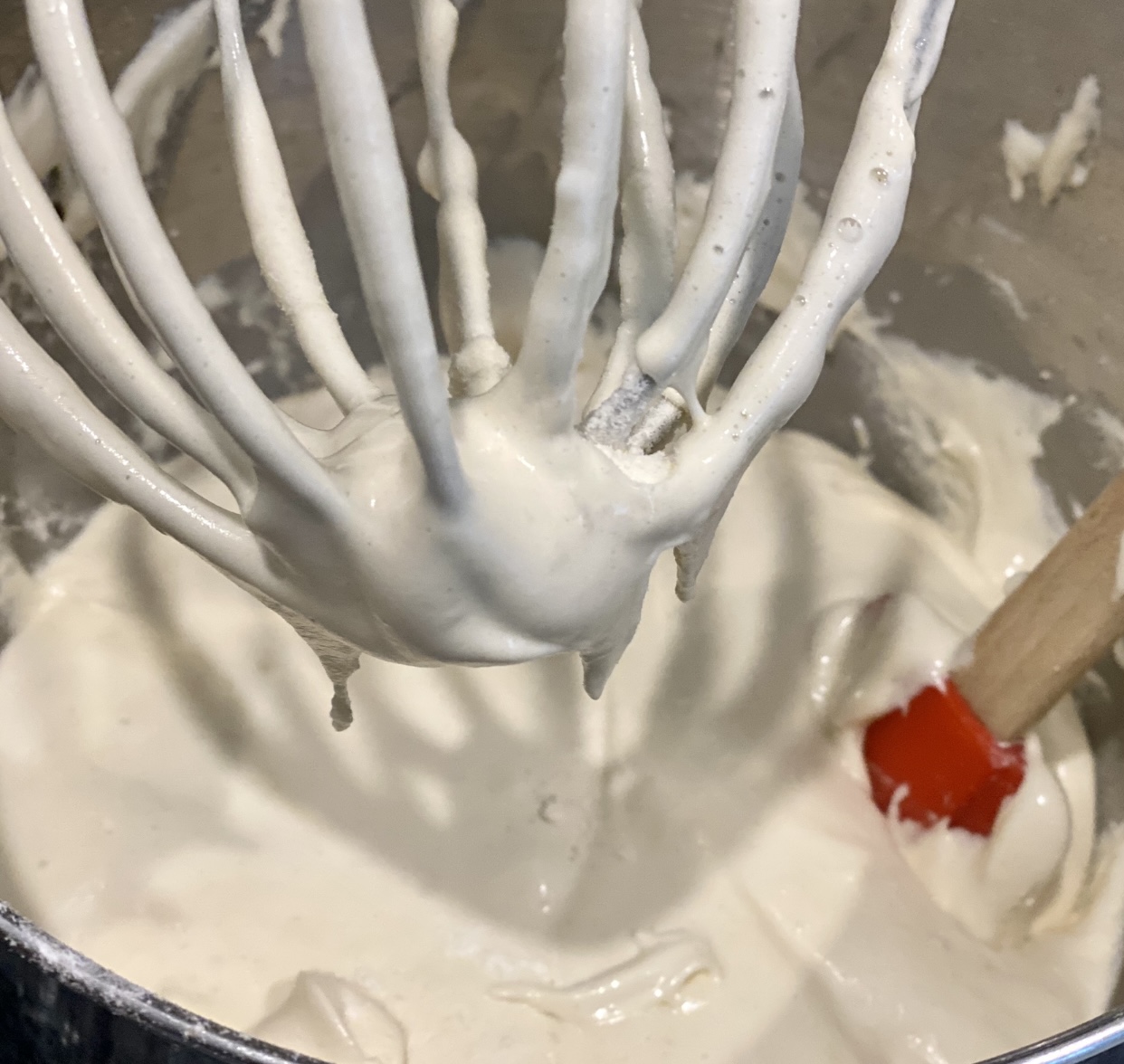
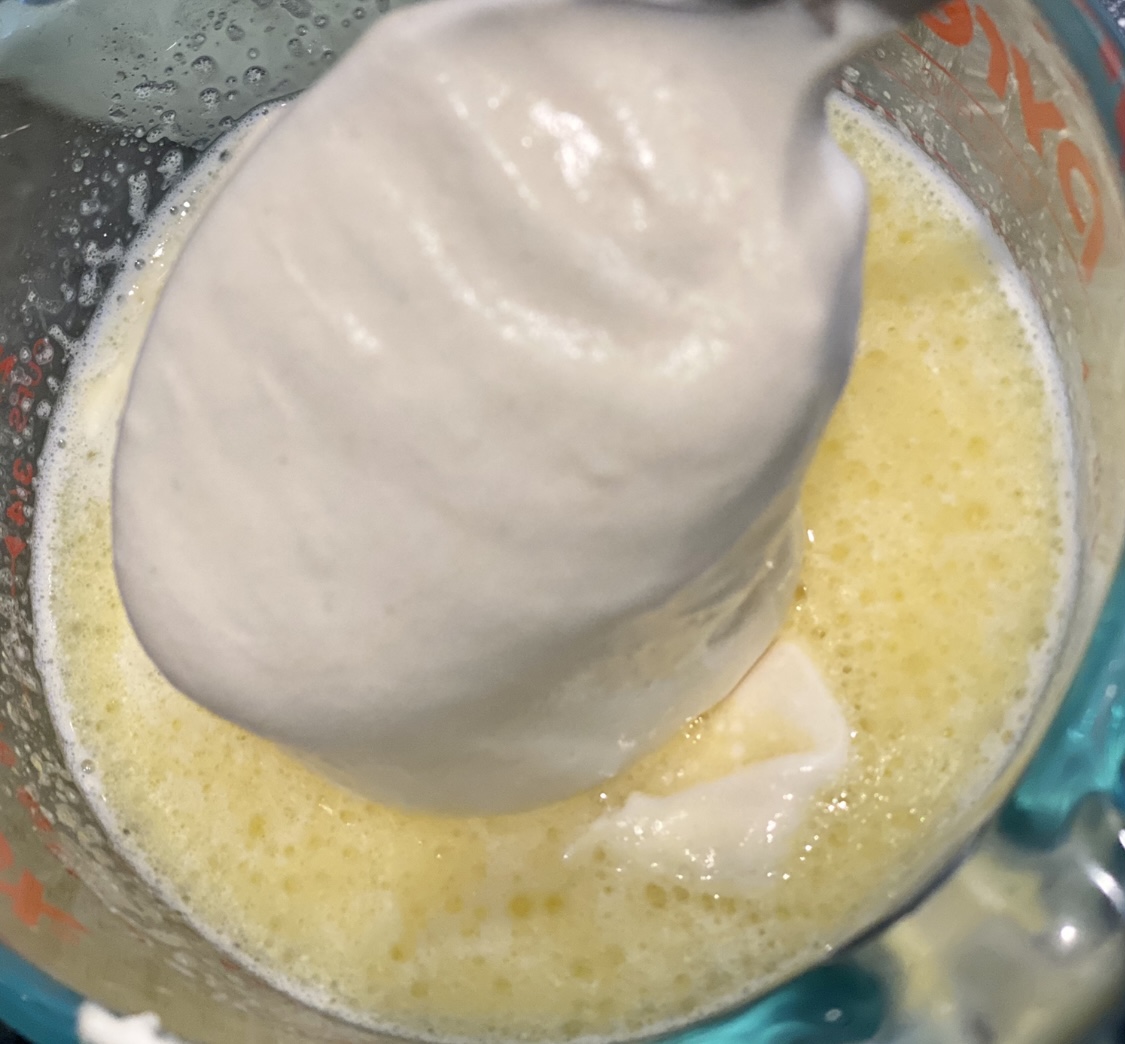



Once the eggs have finished whisking, reduce the mixer speed to low and slowly add in the dry ingredients just until combined. Mix for approximately 20 seconds or until dry ingredients have disappeared but don’t over-mix the batter.



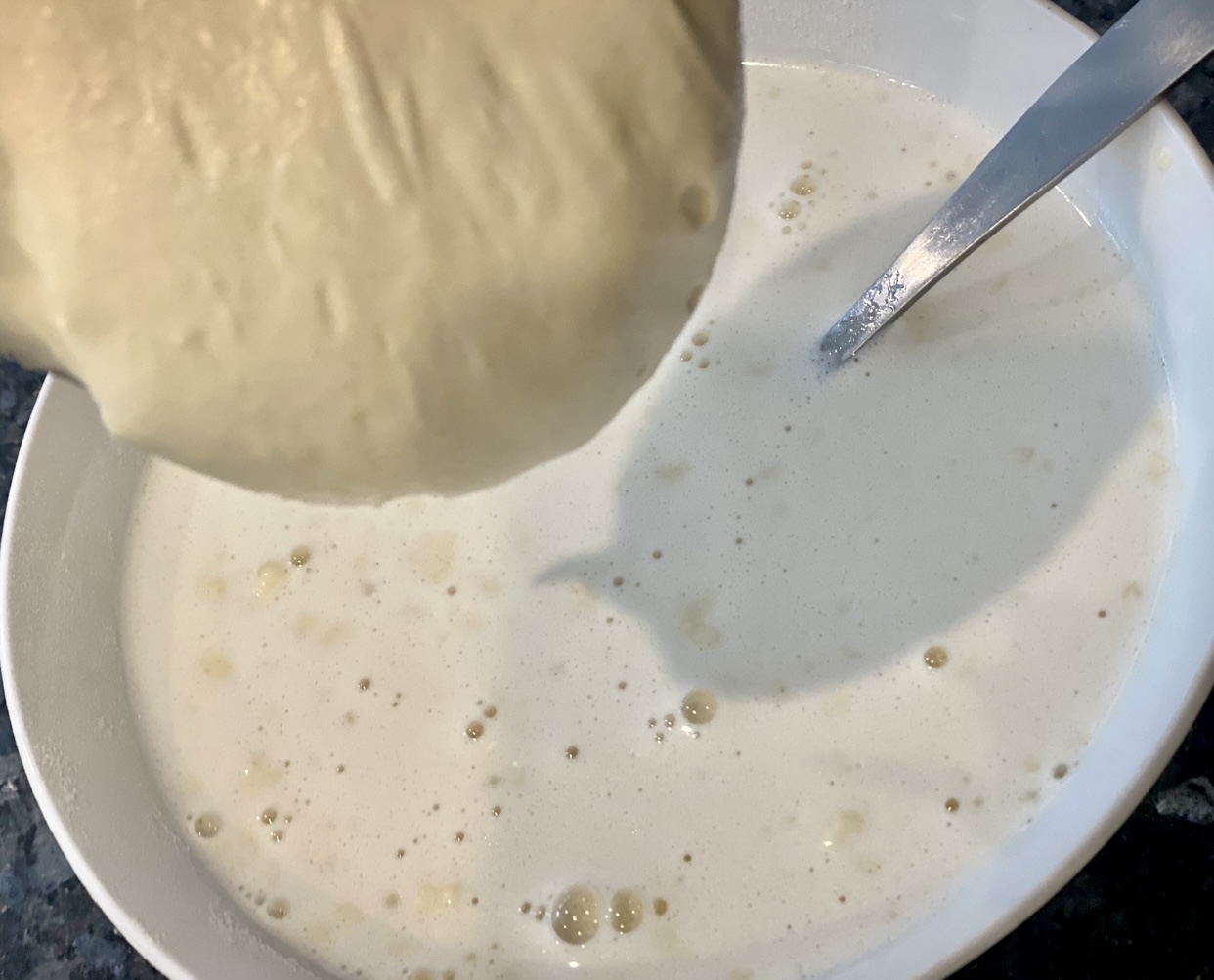




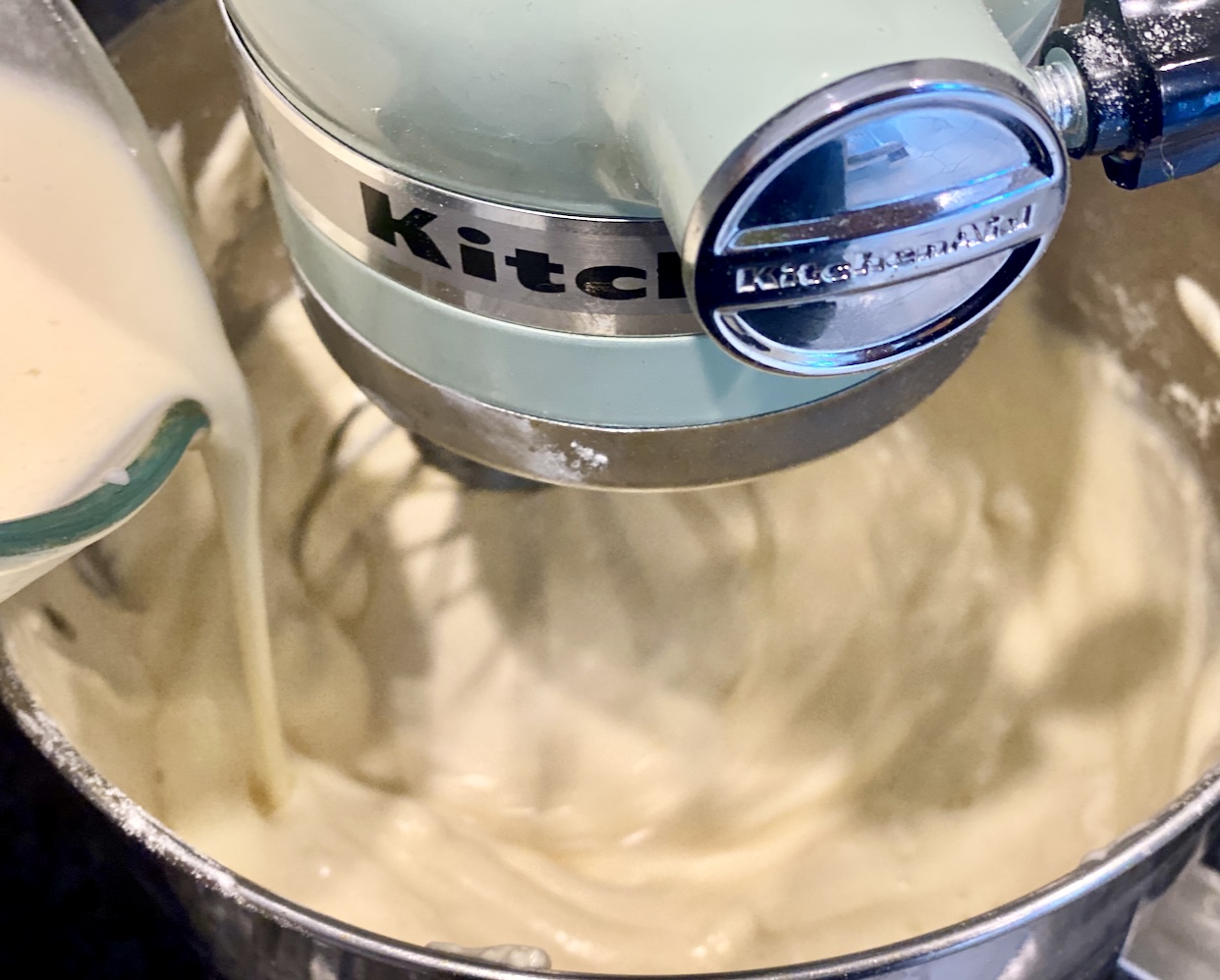

Scoop approximately a cup of batter from the stand mixer bowl and place it into the milk mixture. Whisking the milk mixture until it’s completely smooth with no lumps.
With the mixer on low speed, slowly pour the milk mixture into the remaining batter and whisk for approximately 20 seconds. Remove the bowl from the mixer and scrape the sides and bottom of the bowl and fold in the mixture a few times using a spatula. The batter should be thin and quite runny.
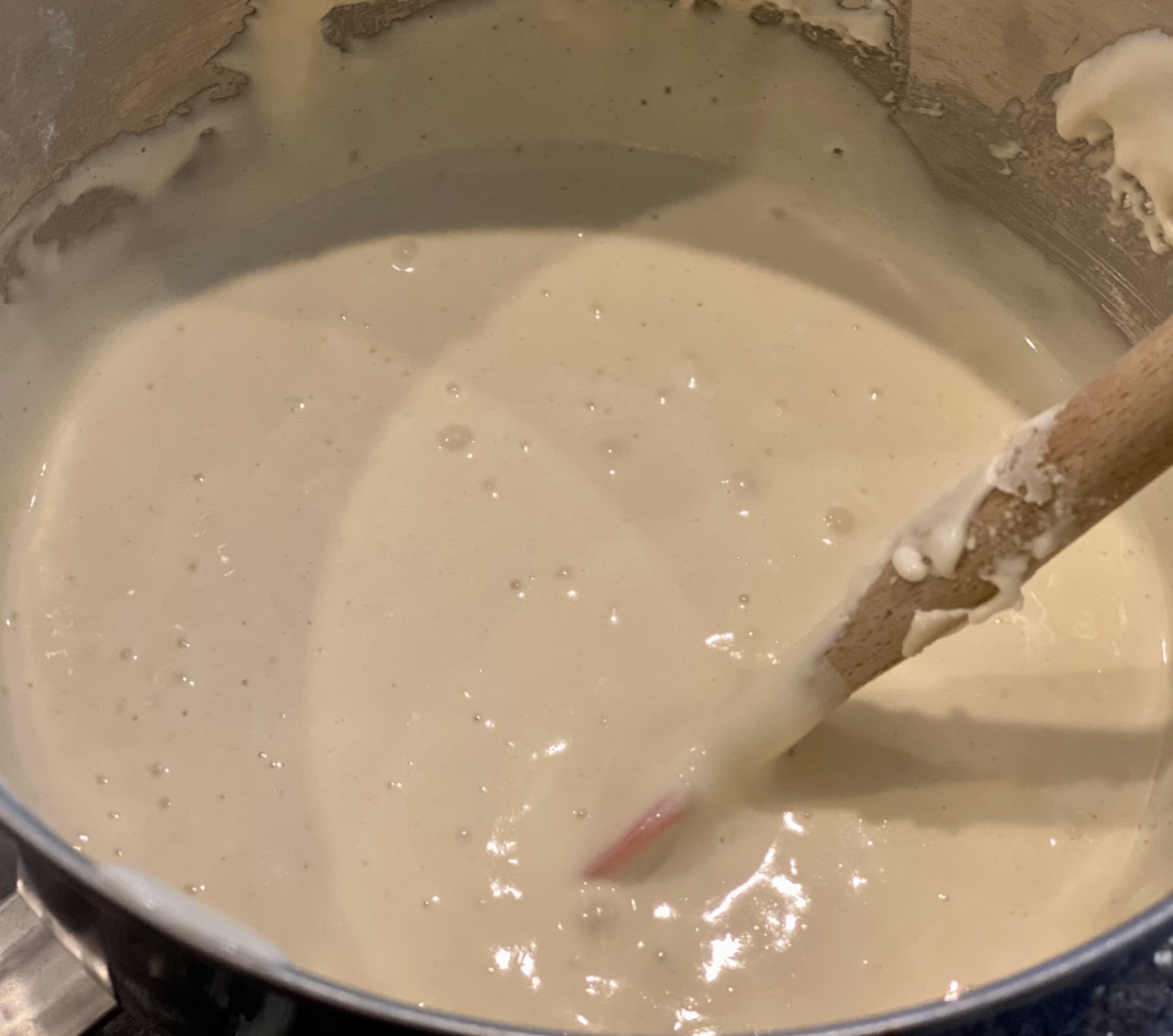

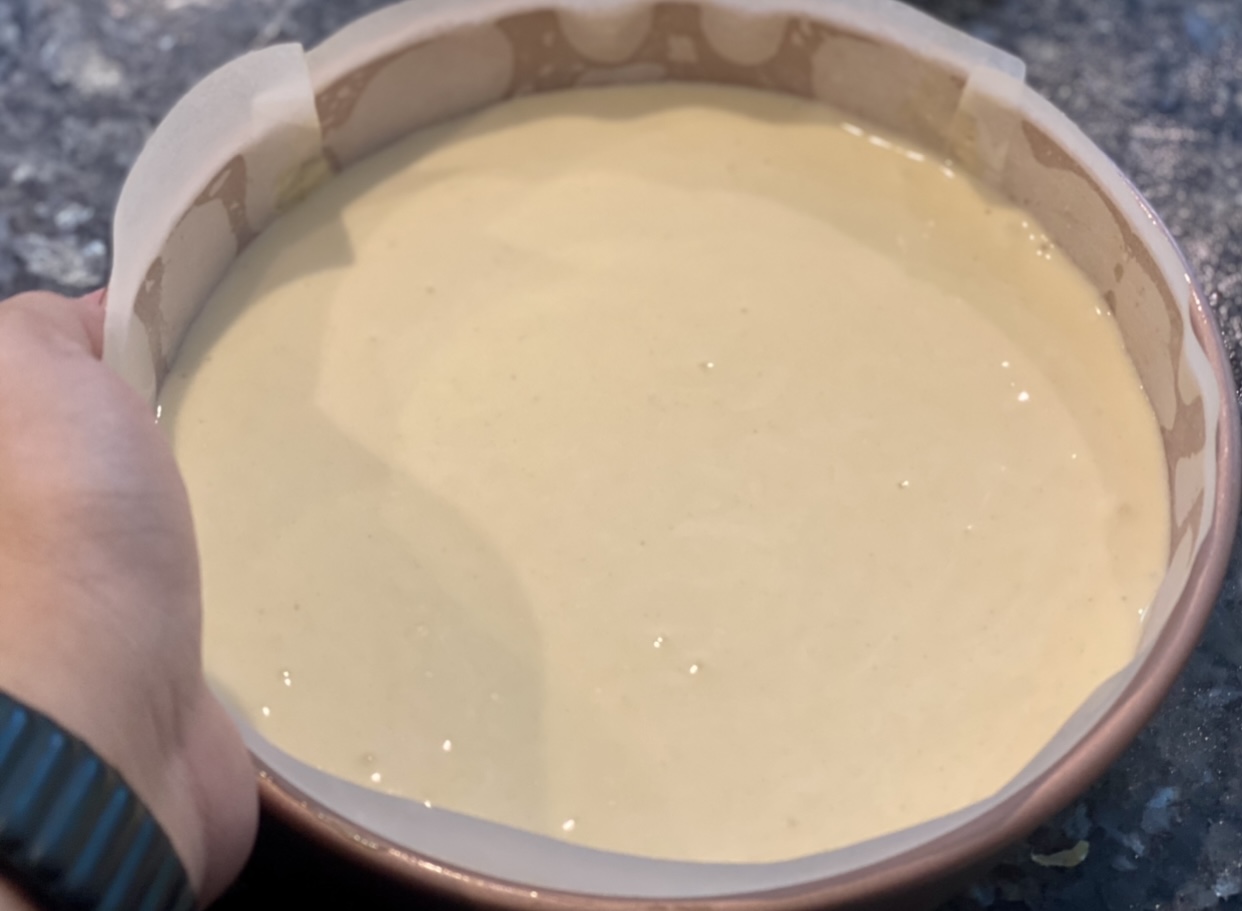





Divide the batter evenly between the cake tins. Tap the tins against the kitchen bench a few times to get rid of any air bubbles. Bake the cake on the middle rack in the oven for 25 minutes or until a skewer comes out clean when inserted in the middle.
Place the cakes tins on top of a cooling rack for 15 minutes, then remove them from the tins and cool them upside down on the rack. The cakes will have some uneven colour on the sides and base, but this won’t affect the taste. Leave cakes at room temperature until completely cooled before filling.
Make the filling and assemble the cake
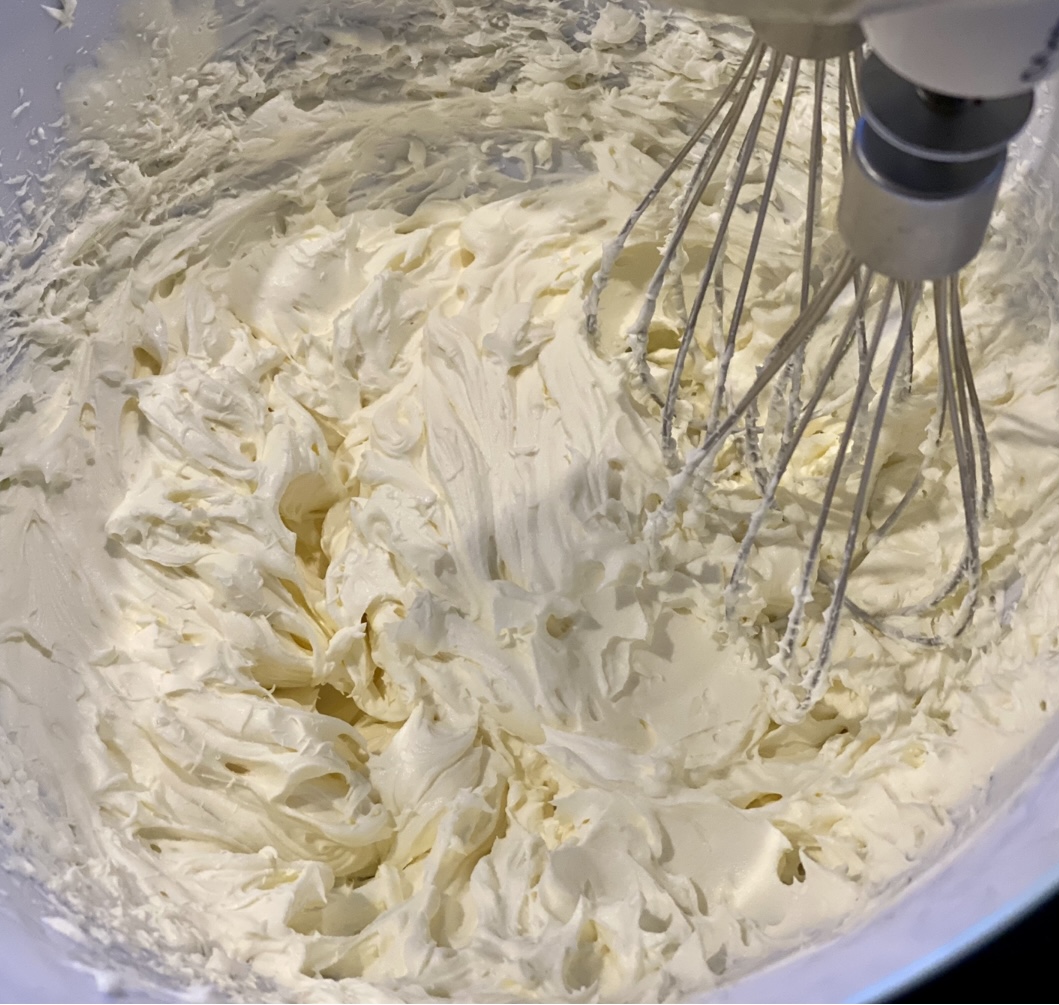







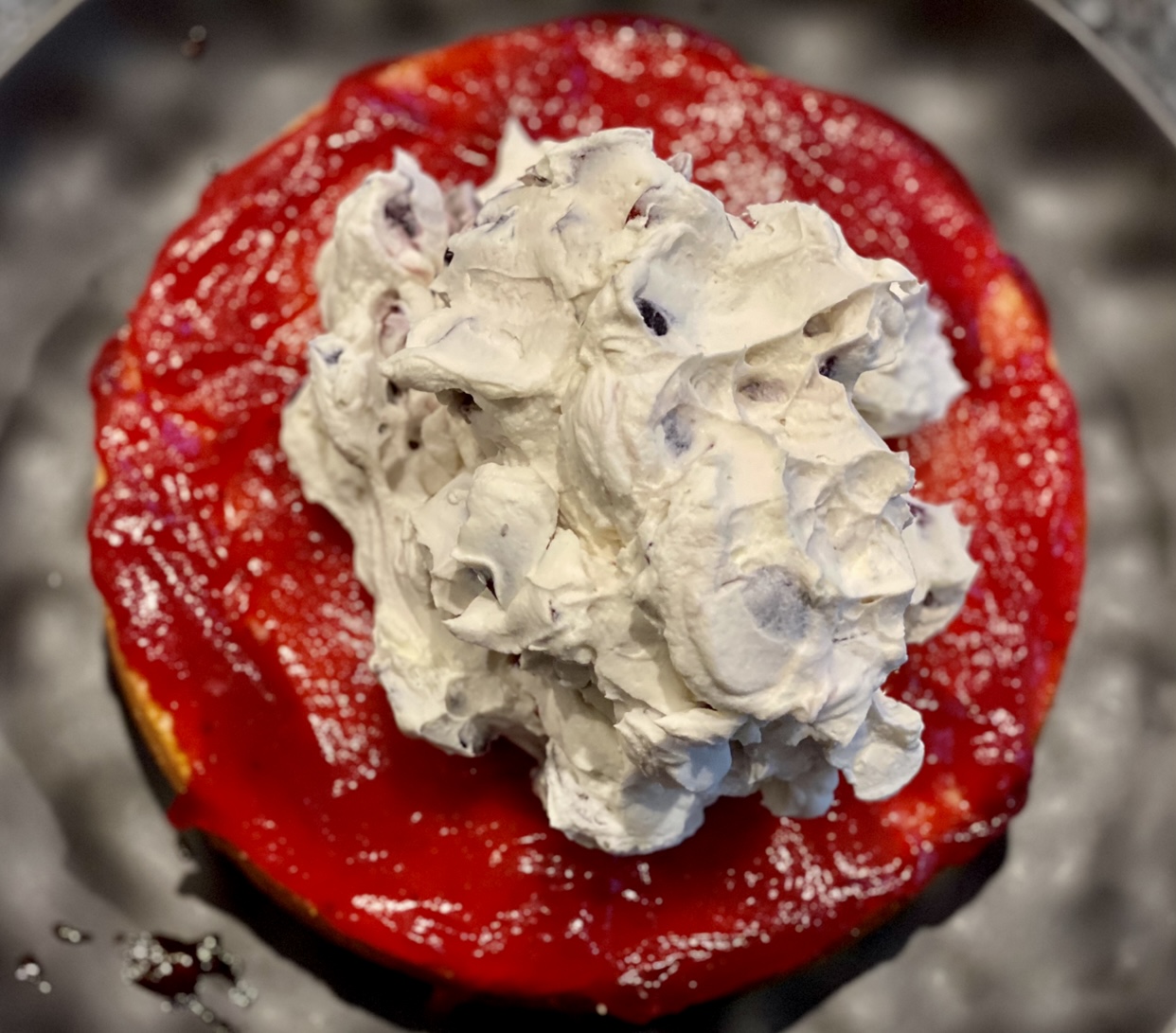

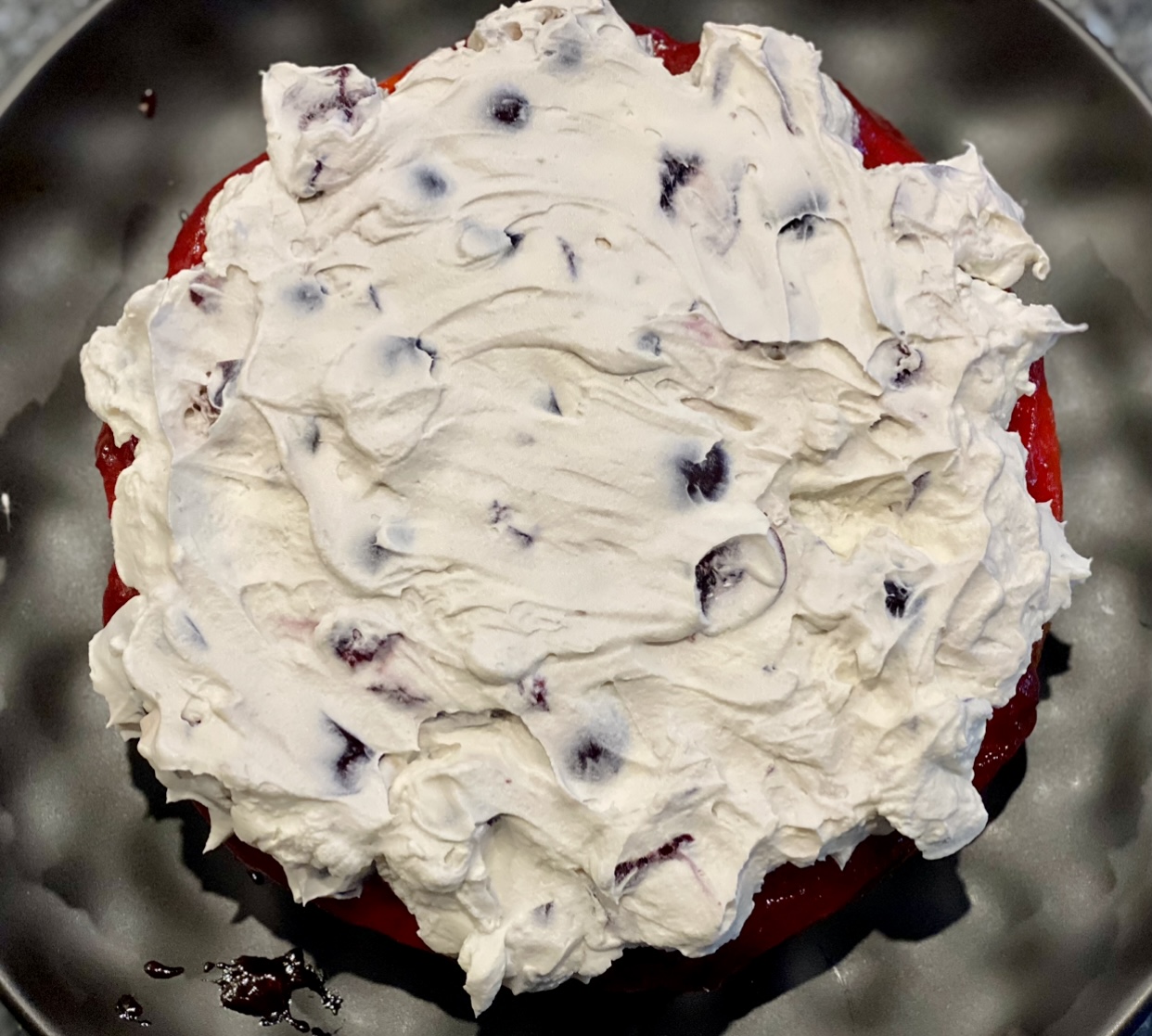

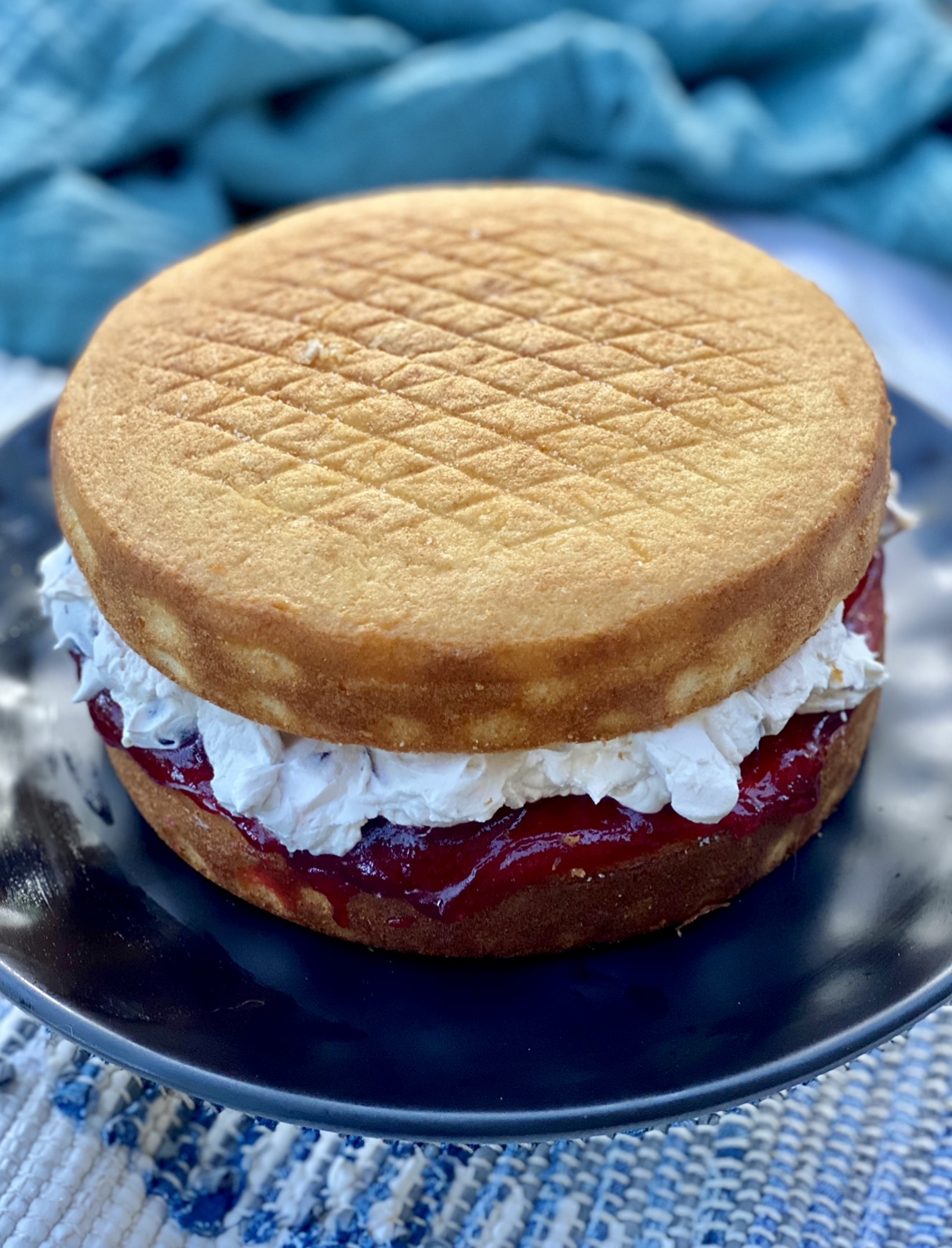

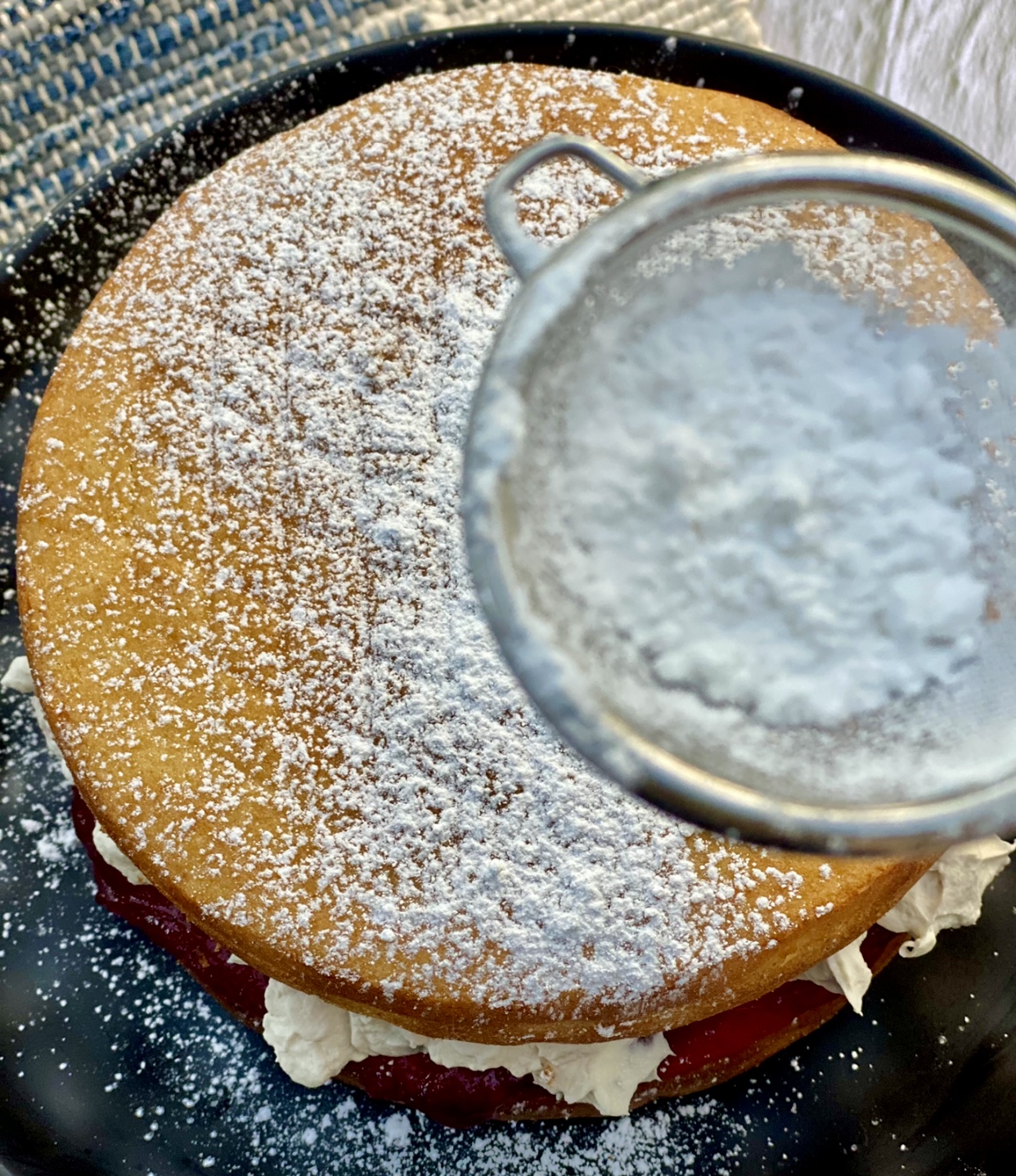

For the cream – Place cream, vanilla extract and icing sugar in a large bowl and whip on high speed using a hand or stand mixer until the cream is fluffy. Fold the chopped cherries into the cream.
If the cakes are a little uneven, slice a thin layer from to the top of the cake to level it up using a bread knife. Arrange the cakes on top of each other, one you’re happy with how it looks, spread jam over the top of the base cake covering all edges. Place the cream over the jam and smooth it out evenly, then place the cake on top to sandwich the filling. Sift icing sugar over the cake and place more cherries on top if desired.
Leftovers – Place the cake in an airtight container and store in the fridge for up to 3 days.
A Third-Party Application calculated the calories and nutritional information. Please use this as an approximate guide only.
Cooking measurements are in Australian standard spoon and cup measurements.
I would love to hear your thoughts or feedback on this post. If you have made this recipe, please show your support by commenting and rating this recipe. You can do this by scrolling down or by clicking the green circle on the left. To prevent spam on this site, an email address is required but it won’t be published.
Cheers (I’ll drink to that) – Cat Tre
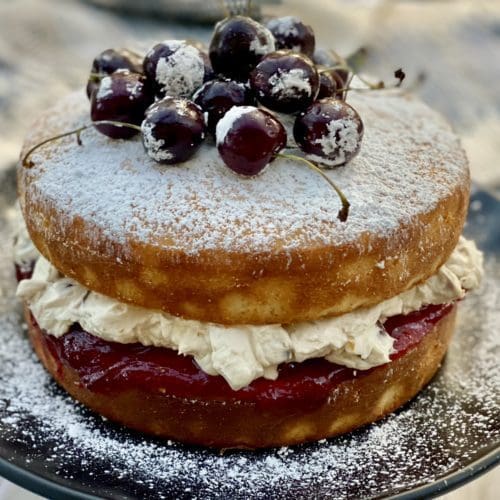

Victoria Sponge cake with fresh cherries
Ingredients
- 4 large eggs (at room temperature)
- 1½ cup caster sugar (or regular white sugar) (NOTE 1)
- 2 cups plain flour (all-purpose) (NOTE 2)
- 2½ tsp baking powder
- ¼ tsp salt
- 115 gm unsalted butter (roughly chopped)
- 1 cup milk
- 3 tsp vegetable oil (or any neutral oil)
- 2 tsp vanilla extract
Topping and filling
- 1 cup thickened cream (whipping cream) (NOTE 3)
- ½ tsp vanilla extract
- 1 tbsp icing sugar (more to dust) (NOTE 4)
- 1 cup fresh chopped and pitted cherries (more to decorate) (NOTE 5)
- ⅓ cup cherry jam (or strawberry/ raspberry jam) (NOTE 6)
Instructions
- Preheat oven to 180°C (360°F) or 160°C (320°F) for fan-forced ovens. Grease and line 2 x 20cm (8in) pan with non-stick baking paper (parchment paper).

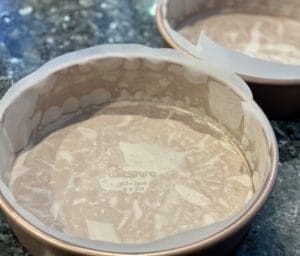
- Whisk the eggs in a stand mixer or handheld mixer with the whisk attachment for 30 seconds on medium speed. With the mixer still running, slowly add in the sugar, then increase speed to medium-high and continue to whisk for 6 to 7 minutes or until light and pale.

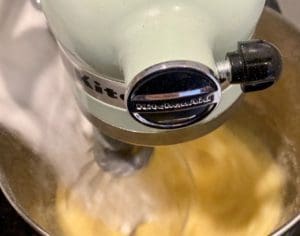
- Whilst the eggs are whipping, combine the dry ingredients, flour, baking powder and salt in a large bowl. Hand whisk a few times to combine the ingredients together and set aside for later.

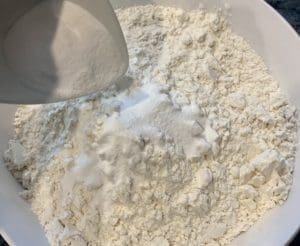
- Prepare the milk mixture – In a large microwave-safe jug/bowl, place in butter and milk and microwave for a couple of minutes just until butter melts. Take care not to boil the milk, then mix in the oil and vanilla. Set aside for later.


- Once the eggs have finished whisking, reduce the mixer speed to low and slowly add in the dry ingredients just until combined. Mix for approximately 20 seconds or until dry ingredients have disappeared but don't over-mix the batter.


- Scoop approximately a cup of batter from the stand mixer bowl and place it into the milk mixture. Whisking the milk mixture until it's completely smooth with no lumps.

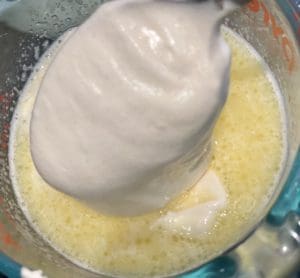
- With the mixer on low speed, slowly pour the milk mixture into the remaining batter and whisk for approximately 20 seconds. Remove the bowl from the mixer and scrape the sides and bottom of the bowl and fold in the mixture a few times using a spatula. The batter should be thin and quite runny.

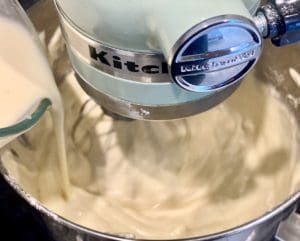
- Divide the batter evenly between the cake tins. Tap the tins against the kitchen bench a few times to get rid of any air bubbles. Bake the cake on the middle rack in the oven for 25 minutes or until a skewer comes out clean when inserted in the middle.


- Place the cakes tins on top of a cooling rack for 15 minutes, then remove them from the tins and cool them upside down on the rack. The cakes will have some uneven colour on the sides and base, but this won't affect the taste. Leave cakes at room temperature until completely cooled before filling.

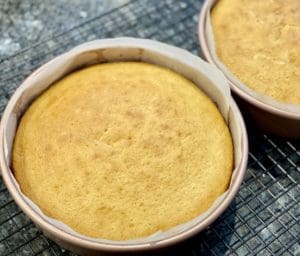
- For the cream – Place cream, vanilla extract and icing sugar in a large bowl and whip on high speed using a hand or stand mixer until the cream is fluffy. Fold the chopped cherries into the cream.

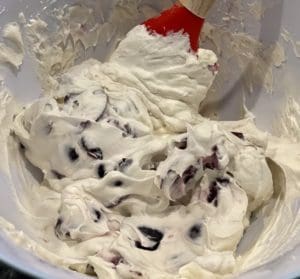
- If the cakes are a little uneven, slice a thin layer from to the top of the cake to level it up using a bread knife. Arrange the cakes on top of each other, one you're happy with how it looks, spread jam over the top of the base cake covering all edges. Place the cream over the jam and smooth it out evenly, then place the cake on top to sandwich the filling. Sift icing sugar over the cake and place more cherries on top if desired.

